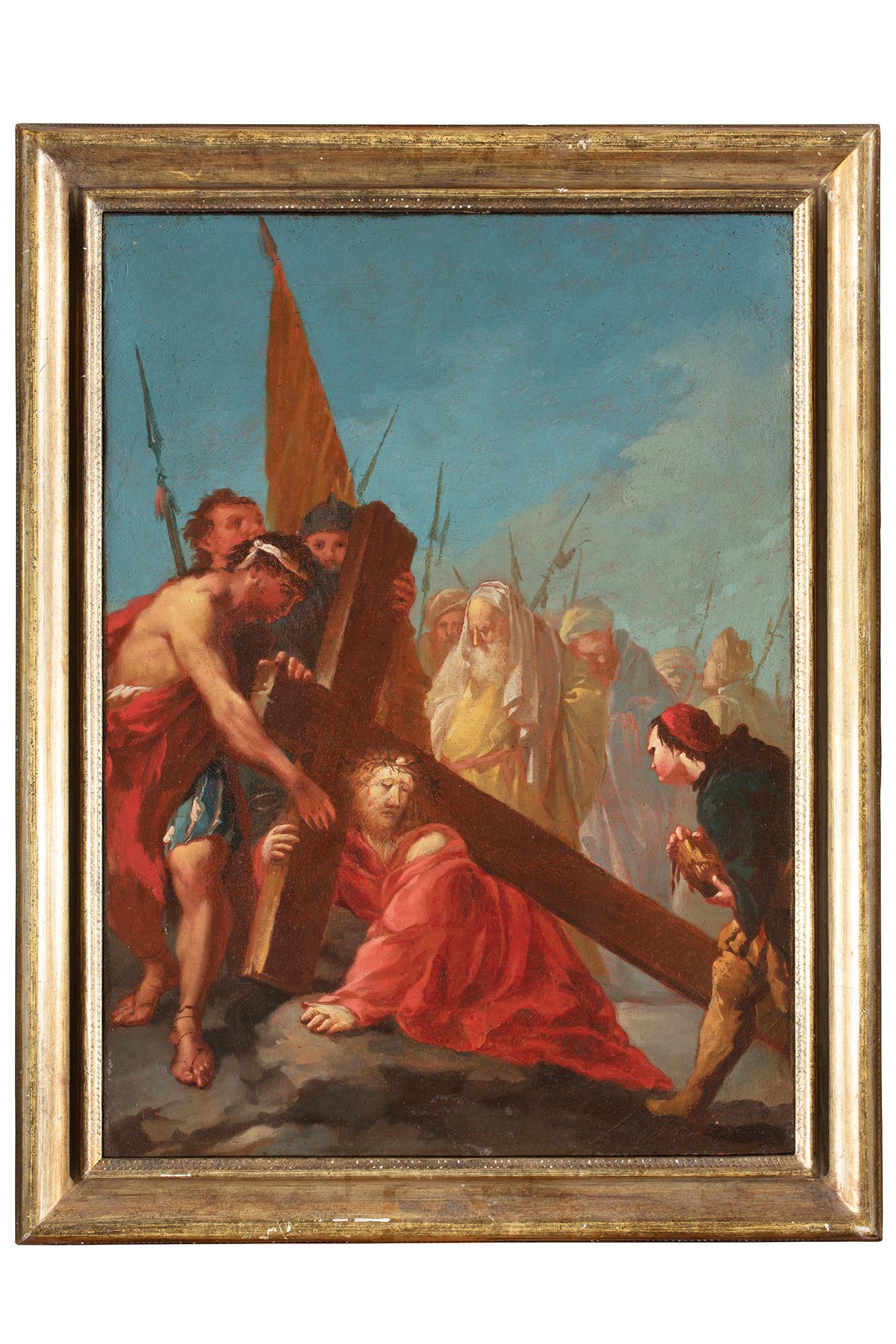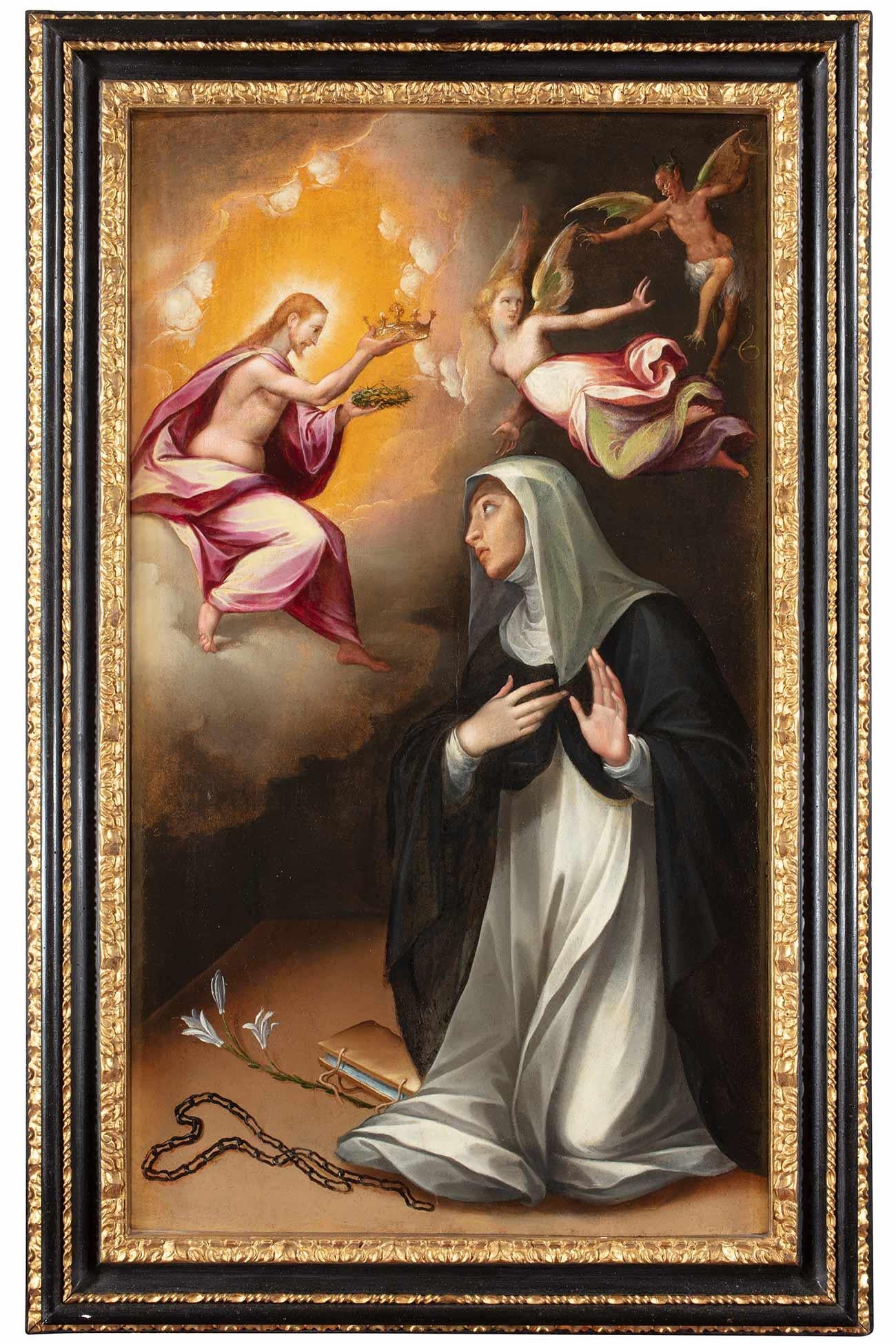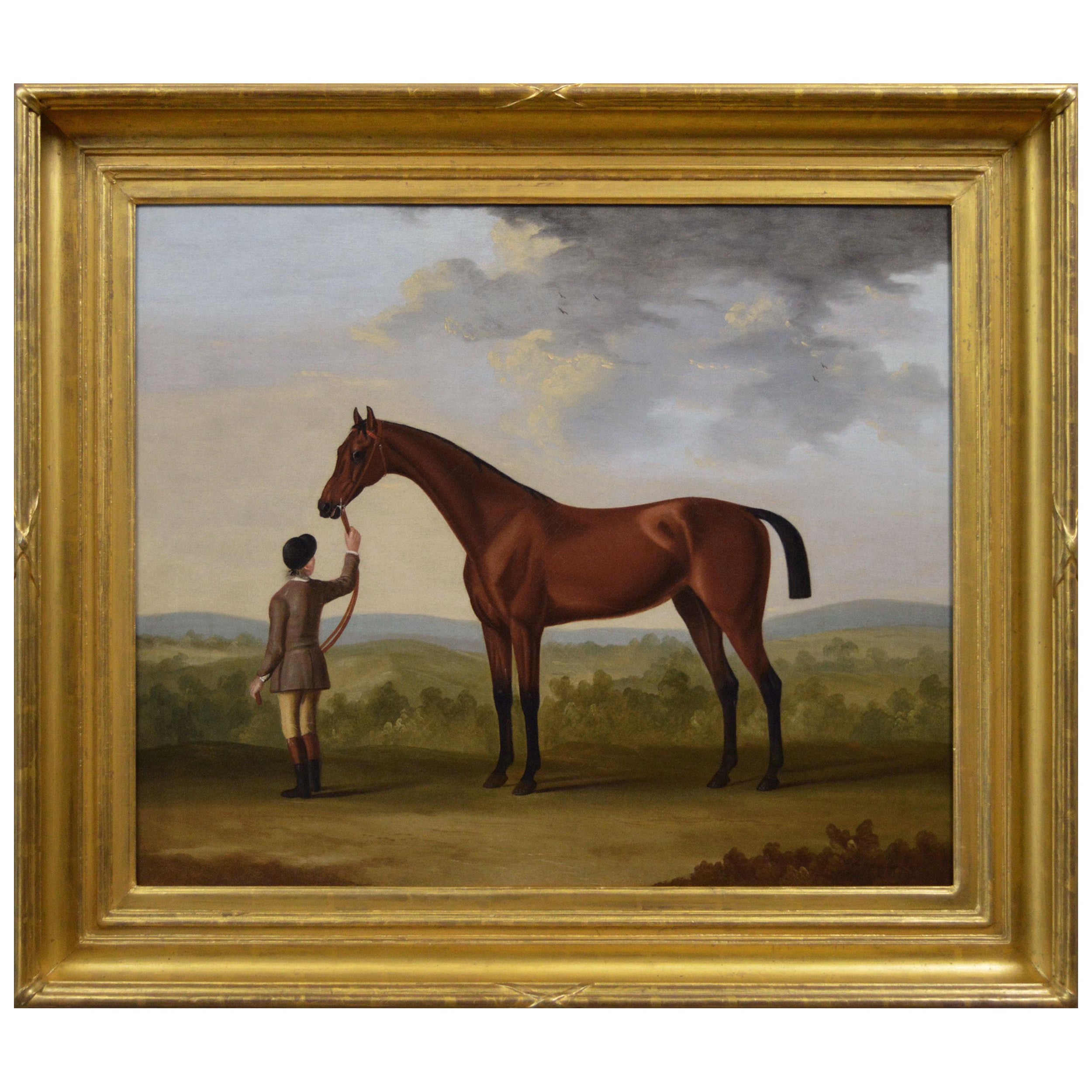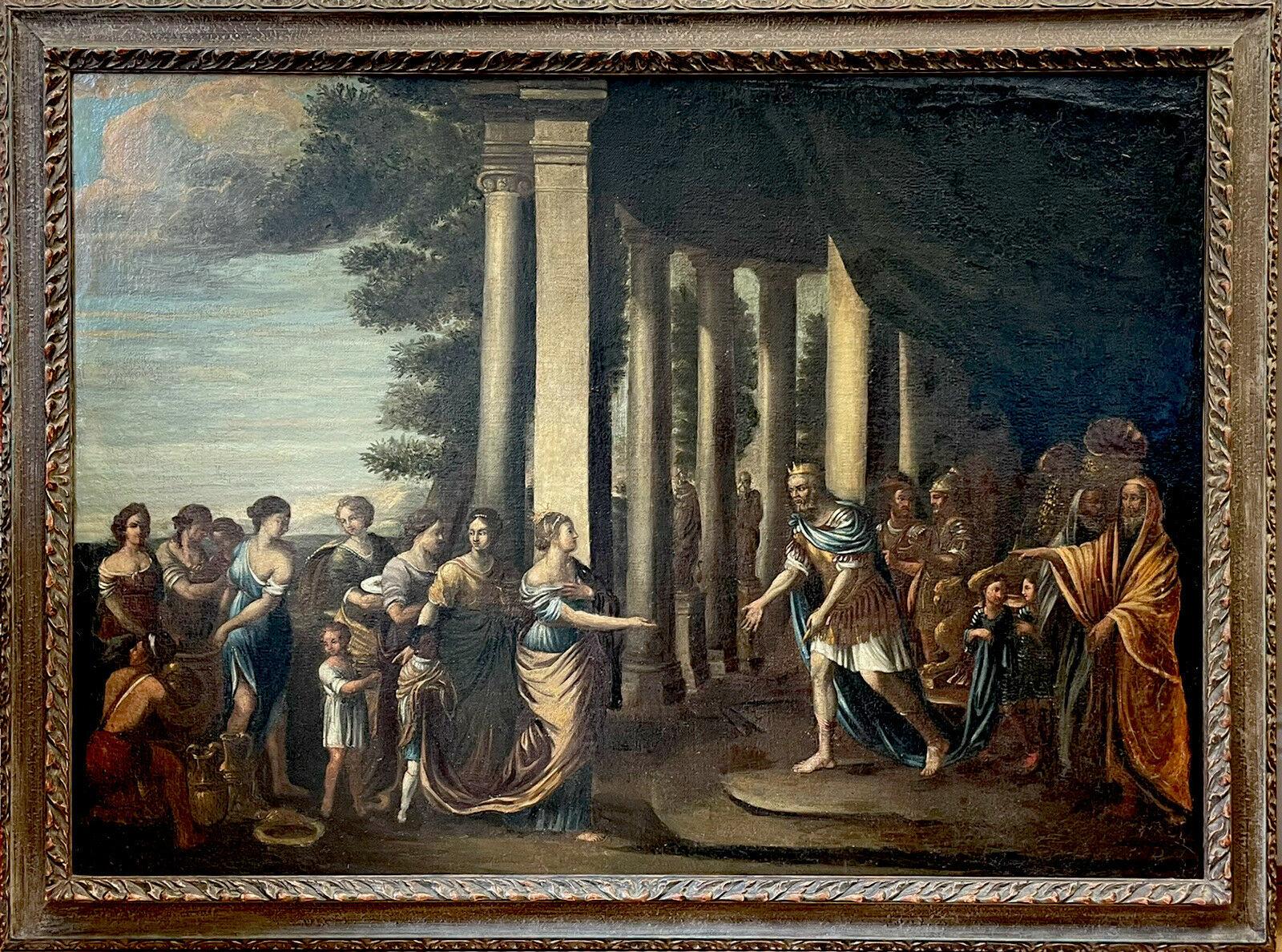Items Similar to A pair of 18th century Italian landscapes with classical ruins and figures
Want more images or videos?
Request additional images or videos from the seller
1 of 8
A pair of 18th century Italian landscapes with classical ruins and figures
About the Item
A pair of 18th century Italian landscapes with classical ruins and figures, circa 1750.
Circle of Giovanni Panini (1691-1765)
Thomas Agnew and Sons, London, labels on the reverse
Each oil on canvas, 60 x 103cm (23 x 40in), in period giltwood frames
Provenance:
A F Marreco, Weidenfeld & Nicolson, 2 Cork Street, London
Sold by Thomas Agnew and Sons, Bond Street, London in 1957 as 'Panini'.
Giovanni Paolo, also known as Gian Paolo Panini or Pannini (17 June 1691 – 21 October 1765), was an Italian painter and architect who worked in Rome and is primarily known as one of the ‘vedutisti’ (view painters). As a painter, Panini is best known for his vistas of Rome, in which he took a particular interest in the city’s antiquities. Among his most famous works are his view of the interior of the Pantheon and his vedute—paintings of picture galleries containing views of Rome. Most of his works, especially those of ruins, have a fantasy element of embellishment, characteristic of capriccio themes where the artist draws on his imagination to group together decorative ruins, unlikely to be found in such close proximity in reality.
These paintings were very popular ‘Grand Tour’ souvenirs for wealthy tourists in the 18th century, allowing them to capture many of their favourite architectural sites combined into an impressive painting which they could take home and prominently display in their grand country homes.
.
- Dimensions:Height: 23.63 in (60 cm)Width: 40.56 in (103 cm)
- Medium:
- Movement & Style:
- Circle Of:Giovanni Paolo Panini (1691 - 1765)
- Period:
- Condition:
- Gallery Location:Bath, GB
- Reference Number:1stDibs: LU95214004762
About the Seller
5.0
Vetted Seller
These experienced sellers undergo a comprehensive evaluation by our team of in-house experts.
Established in 2002
1stDibs seller since 2015
37 sales on 1stDibs
Typical response time: 1 hour
Associations
The British Antique Dealers' AssociationLAPADA - The Association of Arts & Antiques DealersInternational Confederation of Art and Antique Dealers' Associations
- ShippingRetrieving quote...Ships From: Bath, United Kingdom
- Return PolicyA return for this item may be initiated within 3 days of delivery.
More From This SellerView All
- Attributed to John Riley, 17th century English portrait of a girl on a terraceBy John RileyLocated in Bath, SomersetPortrait of a young girl, full-length, wearing a blue silk gown, standing on a terrace beside a classical urn holding a branch with blossom. Attributed to John Riley...Category
17th Century Old Masters Portrait Paintings
MaterialsOil, Canvas
- An English 18th century portrait of James Stanley, standing in a landscapeBy John Hamilton MortimerLocated in Bath, SomersetPortrait of James Stanley (1750 - 1810), circa 1775-1778, full-length, wearing a red coat and breeches and a gold embroidered waistcoat, hold...Category
1770s English School Portrait Paintings
MaterialsOil, Canvas, ABS
- A large English 18th century painting of a Chestnut horseBy Thomas BeachLocated in Bath, SomersetA saddled chestnut hunter tethered to a post at the entrance to stables with a wooded landscape and a hill beyond. Signed and dated lower left, 'T. Beach pt., 1785'. Provenance: Anonymous sale, London, Christie's 28 May 1999. lot 15 Thomas Beach was essentially known as a portrait artist and the present painting is a rare example of his skill as an animal painter. His ability to convey a sense of the character of his sitters is evident here in the remarkably sensitive portrayal of the horse's expression. Beach painted...Category
18th Century English School Animal Paintings
MaterialsCanvas, Oil
- 19th century English School, Bay Horse and a Terrier in a LandscapeLocated in Bath, SomersetA bay hunter and a black and white short haired dog (possibly a bull terrier) in an extensive English landscape. a rustic barn in the near distance. Indistinctly signed 'Br...' and d...Category
Early 19th Century English School Animal Paintings
MaterialsCanvas, Oil
- English early 19th century painting of a chestnut hunter in a landscapeBy John Ferneley SeniorLocated in Bath, SomersetA painting of a chestnut hunter in a landscape with a horse and rider accompanied by two hounds by a woodland river in the distance. Signed and inscribed 'Melton Mowbray', lower left. Oil on canvas in a giltwood frame. John Ferneley Sr (1782-1860) was born the son of a Leicestershire wheelwright, the youngest of six children. He is known as one of the great British equine artists, perhaps only second to Stubbs in terms of raw ability. Ferneley originally worked with his father, until by chance the Duke of Rutland saw some of his work on the side of a cart on which Ferneley and his father had been working. The Duke was so impressed with Ferneley that he persuaded John's father to allow him to become the pupil of Benjamin Marshall. Ferneley was so talented that apparently he produced almost perfect copies of his tutor's paintings and they were said to have been indistinguishable from the master’s. Marshall also enrolled him as a student of the Royal Academy Schools. In 1804 Ferneley paid a man named Thomas Harrison...Category
Early 19th Century English School Animal Paintings
MaterialsCanvas, Oil
- A portrait of a lady and her daughter with an exotic birdBy Michael DahlLocated in Bath, SomersetA portrait of a lady three-quarter length, seated in an interior, wearing a red silk gown draped in a pink silk sash with an exotic bird perched on her hand and one arm resting on a stone plinth, her young daughter wearing a green silk gown standing at her side. Oil on canvas, housed in a period 'Lely' giltwood frame. This double portrait was painted at the height of Dahl's career in circa 1715 when Dahl had become firmly established as one of the leading portrait painters in Britain. Although the identities of the sitters are currently unknown, it is a sensitive depiction of a close and affectionate bond between a mother and daughter, with the young girl's hand resting affectionately on her mothers lap. The tamed exotic bird adds a charming decorative element which also serves to convey the high social status of the lady, given only the very wealthy would be able to own such a rare and expensive pet and the lively colouring of the bird's feathers is reflected in the colours of the sitters' silk gowns. Provenance: Private collection, London Michael Dahl (Stockholm 1659-1743 London) was born in Stockholm in Sweden and studied under Martin Hannibal (d 1741) and later with David Klöcker Ehrenstrahl. In 1682 he travelled to London, where he became acquainted with Godfrey Kneller and Henry Tilson, and in 1685 he left for Europe with Tilson, working briefly in Paris before continuing to Venice and Rome, where they stayed for about two years. In Rome Dahl converted to Roman Catholicism and gravitated towards the circle of Christina, former Queen of Sweden, who sat for him (Grimsthorpe Castle, Lincs). He returned to England with Tilson via Frankfurt and arrived in London in 1689, staying in England for the remainder of his career. During Dahl's absence, Kneller had consolidated his supremacy in London as the most fashionable portrait painter, but Dahl rapidly became Kneller’s closest competitor. His patrons probably had roots in the Swedish diplomatic circles, but it expanded as a result of his ability and his agreeable personality. His prices were lower than those of Kneller and he favoured softer, more diffused, colour tones and could respond to his sitters with sincerity and humanity. Politically, Kneller supported the ascendant Whigs while Dahl was a Tory, but they frequently painted the same sitters from both parties, and in spite of fundamental differences in technique and temperament, their work was sometimes similar in appearance. Dahl was prolific but rarely signed his work, and comparatively few of his portraits were engraved in mezzotint, the method used by Kneller to widen his reputation. By 1690 he had painted the aged Duke of Schomberg (engraved by William Faithorne) and Prince George of Denmark (London, Kensington Palace). He was ignored by William III but received commissions from Princess Anne, including one for a portrait of herself (Oakly Park, Ludlow, Salop). He also painted the future Duke and Duchess of Marlborough, and his informal portrait of the Duchess (Althorp House, Northants), formerly attributed to Kneller, is perhaps the most intimate of all images of her. During the 1690s he secured the patronage of Charles Seymour, the ‘Proud’ 6th Duke of Somerset, who ordered a series of seven full-length portraits of notable contemporary beauties from Dahl (1690s; Petworth House, W. Sussex, NT). This was originally a scheme similar to Kneller’s more famous ‘Hampton Court Beauties’, but the portraits were subsequently reduced to three-quarter-length formats. The features of the sitters are not individualized, but they possess a decorative, languorous glamour that recalls Lely rather than Kneller. Somerset gave Dahl further employment over the next 25 years. In 1698, following the death of Klöcker Ehrenstrahl, Dahl was offered the post of court painter at Stockholm, which he apparently refused, preferring to remain in London at his studio in Leicester Fields, near the Swedish legation. In about 1700 he was joined by a young compatriot, Hans Hysing, who worked with him for many years. Dahl seems not to have married until after 1708, He had a son Michael (d. 1741), also a painter, of whose work nothing is known, and two daughters. After the accession of Queen Anne in 1701, she and Prince George sat for a number of official portraits. His royal patronage ceased with Queen Anne’s death, and when Dahl refused to paint the infant Duke of Cumberland in 1722. He was suspected of Jacobite sympathies, and relations had cooled between him and the Swedish legation. However, his practice continued to prosper, and he acquired another important patron in Edward Harley, 2nd Earl of Oxford, who shared his political views and whose circle included the architect James Gibbs and the poets Matthew Prior and Alexander Pope, all of whom Dahl painted. Oxford commissioned several portraits of himself. In the earliest (1719; Welbeck Abbey...Category
Early 18th Century Old Masters Portrait Paintings
MaterialsCanvas, Oil
You May Also Like
- 19th Century By Giustino Menescardi Ascent to Calvary Oil on CanvasLocated in Milano, LombardiaGiustino Menescardi (Milan, c. 1720 - Venice, after 1779) Ascent of Calvary Oil on canvas, cm. 47 x 36 - with frame cm. 57x43 Shaped and gilded wooden cassetta frame Publications: Bozzetti, modelletti, sketches: dalla collezione di Giorgio Baratti...Category
Early 18th Century Old Masters Landscape Paintings
MaterialsCotton Canvas, Canvas, Oil
- 17th Century by Simone Cantarini Adoration of The Magi Painting Oil on CanvasLocated in Milano, LombardiaSimone Cantarini (Pesaro 1612 - Verona 1648) Adoration of the Magi Oil on paper applied to canvas, cm. 16,5 x 24 – with frame cm. 22 x 29 Antique sh...Category
Early 17th Century Old Masters Figurative Paintings
MaterialsCanvas, Cotton Canvas, Oil
- REGATTA IN THE GULF -English School Italian Sealing boat Oil on canvas PaintingBy John StevensLocated in Napoli, ITRegatta in the gulf - John Stevens Italia 2006 - Oil on canvas cm.40x80. Using thin washes of oil paint, John Stevens slowly builds up his highly detailed paintings of scenes of nava...Category
Early 2000s Old Masters Landscape Paintings
MaterialsOil, Canvas
- 16th Century by Cristofano Roncalli Saint Catherine of Siena Oil on CanvasLocated in Milano, LombardiaCristofano Roncalli (Pomarance 1552 - Rome 1626) Saint Catherine of Siena chooses the crown of thorns oil on wood, cm. 101,5x59.5 - with frame cm. 120x76 Shaped, carved and sculpted wooden cassetta frame, partly gilded and partly ebonized wood Expertise: Marco Ciampolini The marvellous scene that opens before our eyes is that of Christ's apparition to Saint Catherine of Siena; she must choose between a golden crown, the symbol of earthly royalty, and a crown of thorns, the symbol of virtuous Christian sacrifice. Catherine does not hesitate to choose the crown of thorns, her life in imitation of...Category
16th Century Old Masters Landscape Paintings
MaterialsCanvas, Cotton Canvas, Oil
- 18th Century sporting horse portrait oil painting of a race horse and groomBy Francis SartoriusLocated in Nr Broadway, WorcestershireFrancis Sartorius British, (1734-1804) Bay Hunter & Groom Oil on canvas, signed Image size: 24.25 inches x 29.25 inches Size including frame: 32 inches x 37 inches A wonderful spor...Category
18th Century Old Masters Animal Paintings
MaterialsOil, Canvas
- HUGE 17thC ITALIAN OLD MASTER OIL PAINTING - KING & COURT FIGURES ROMAN BUILDINGLocated in Cirencester, GloucestershireArtist/ School: Italian School, 17th century. Title: A King and Queen before court figures, amidst a classical landscape with Roman columns. Medium: oil painting on canvas, framed ...Category
17th Century Old Masters Figurative Paintings
MaterialsOil, Canvas
Recently Viewed
View AllMore Ways To Browse
Pair Of Landscapes
Landscape Art Pair
Antique Italian Figures
Classical Ruins
Antique Classical Painting
Pair Of Antique Landscapes
Antique Art Of Italy Pair
Pair Of Italian Paintings
Ruins Landscape Painting
Oil Painting Antique Classical
18th Century Landscape Italy
18th Century Italian Landscape
Old Master Picture
Old Antique Picture Frames
Oil Painting Ruins
Pair Italian Figures
Pair 18th Century Painting
18th Century City View





